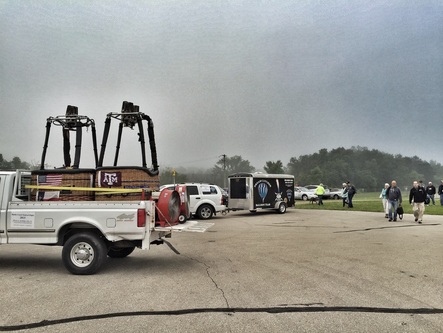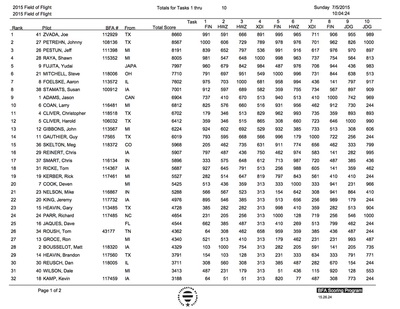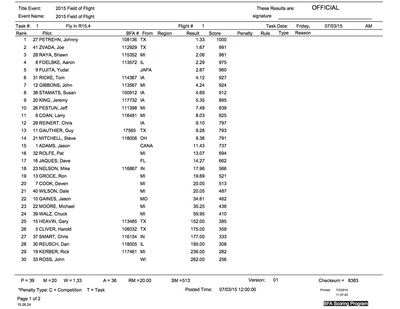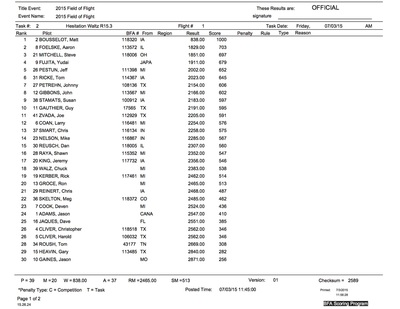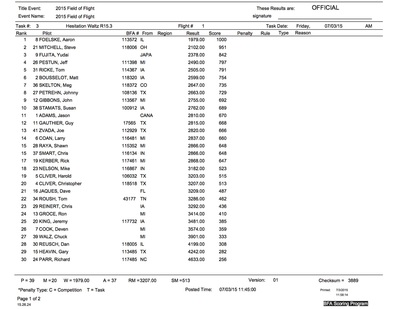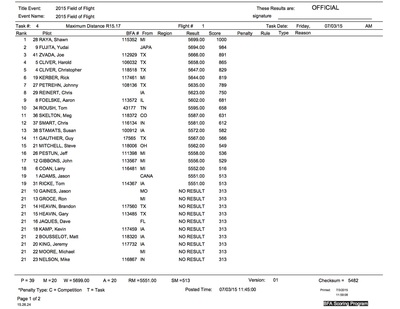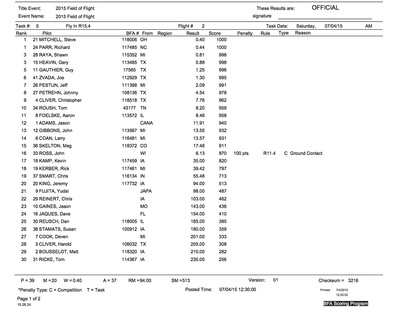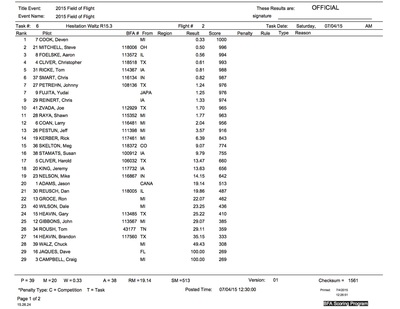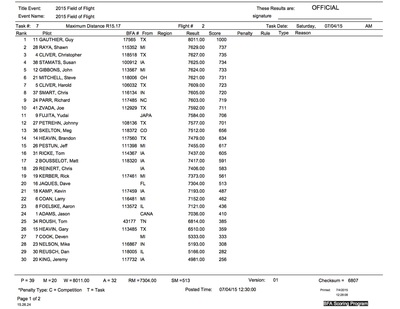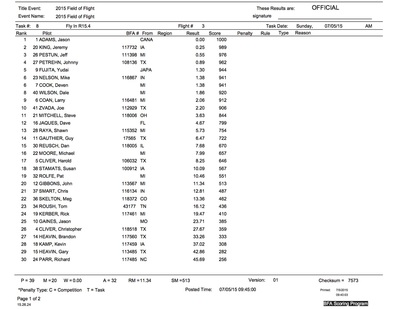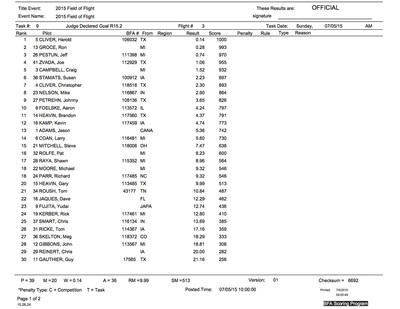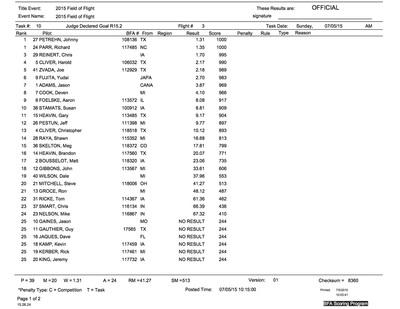Battle Creek Field of Flight
Battle Creek, MI USA
July 1-5, 2015
REPORTED BY JOE ZVADA
Battle Creek, MI USA
July 1-5, 2015
REPORTED BY JOE ZVADA
|
Battle Creek was one of my first competitions ten years ago. Without a reliable vehicle of my own, I stuffed my Aurora into my mom’s mini-van and made the trip to Michigan. Fast forward ten years and I now own an adequate vehicle, but for this week I’d be borrowing a balloon. Not much has changed I guess. In the recap below I've included personal anecdotes from my flying and decision making during the flights.
The event in Battle Creek is one of the few leading up to the US Nationals in Longview with lots of potential for many tasks. Pilots from across the country made the trip in hopes of fair weather and good competition. The event started Wednesday July 1 with a breezy practice flight where only a couple balloons flew. Dawn on Thursday brought clear skies, but just before briefing a fast moving scud cloud layer moved into the area bringing visibility down to less than a mile. The flight was cancelled. |
Results: |
Thursday Evening - FIN
Balloons got in the air with a one part fly in to the Battle Creek airport. Evening tasks would not be included in the overall event scores, but did have a separate per task prize money pay out. Breezy conditions along with a direction coming from the downtown area made finding a launch difficult. Despite the wind speeds, conditions were fairly steerable resulting in several good passes. Landing was permitted at the airport after the target and, just for fun, officials added a landing competition to the evening. A panel of officials judged the landings and issued scores between 1 and 10.
Balloons got in the air with a one part fly in to the Battle Creek airport. Evening tasks would not be included in the overall event scores, but did have a separate per task prize money pay out. Breezy conditions along with a direction coming from the downtown area made finding a launch difficult. Despite the wind speeds, conditions were fairly steerable resulting in several good passes. Landing was permitted at the airport after the target and, just for fun, officials added a landing competition to the evening. A panel of officials judged the landings and issued scores between 1 and 10.
Friday Morning - FIN, HWZ, HWZ, XDI
Excellent conditions led to four tasks Friday Morning: FIN, HWZ, HWZ, XDI. Winds flowed generally from the southeast to northwest. The direction had pilots searching for launch in a rural area where crops and livestock left few options for a balloon launch. Most chose a launch several degrees off the most preferred line in hopes of making up for the difference in the air.
Pilots scored well on the FIN with the top 14 pilots achieving results of less than 10m. I took a higher line into the target not wanting to trust the lowest of winds. A good throw from a hundred feet or so (my best of the weekend) resulted in 1.67m.
The two HWZ tasks were set on a 325-330 degree bearing from the FIN which was about 10 degrees further right than what pilots could find in the winds below 2000ft. Forecast winds aloft showed the possibility of a north easterly wind that would allow pilots to achieve a score on the HWZs, but the winds would go left on the climb before they would turn back to the right. So anyone trying this would risk the right not being as forecast making them further left of the lower balloons on the GPS scores. In the end nobody risked the climb and pilots just tried to sneak further right than other competitors to get better GPS logger scores.
My thought process on the HWZ: I thought I was in the top third of the field in regards to distance to the HWZs which would equate to 600-700pt scores. If I had climbed and the right wasn’t there I was looking at probable 200pt scores. For me there was too much to lose and not enough to gain to try the climb to find more right. If my position in the pack would have been to the left I would have a lot less to lose on the potential climb and I would have definitely given it a shot.
The Max Distance was set up as a box with boundaries along gridlines. Pilots would be measured from a set point (listed on the task sheet) to their exit point of the box. The 315 degree heading pilots were holding put the south west corner of the box in play. Some careful plotting identified the best result was the bottom corner in the current wind conditions. Shawn Raya won the task by just a few meters over Yudai Fujita. The two flew out of the box very very close to the boundary corner.
The flight from the FIN past the two HWZs and into the XDI box was very long. The time allowed for a detailed examination of distances in the box. It became clear that there was not enough right turn to achieve a better result than exiting the box in the southwest corner. I was hoping that I’d be one of the few that spotted this, but as the pack moved closer to the box, balloons started descending to catch a left turn towards the corner. Shawn and Yudai did a great job of flying to the corner of the imaginary box.
Excellent conditions led to four tasks Friday Morning: FIN, HWZ, HWZ, XDI. Winds flowed generally from the southeast to northwest. The direction had pilots searching for launch in a rural area where crops and livestock left few options for a balloon launch. Most chose a launch several degrees off the most preferred line in hopes of making up for the difference in the air.
Pilots scored well on the FIN with the top 14 pilots achieving results of less than 10m. I took a higher line into the target not wanting to trust the lowest of winds. A good throw from a hundred feet or so (my best of the weekend) resulted in 1.67m.
The two HWZ tasks were set on a 325-330 degree bearing from the FIN which was about 10 degrees further right than what pilots could find in the winds below 2000ft. Forecast winds aloft showed the possibility of a north easterly wind that would allow pilots to achieve a score on the HWZs, but the winds would go left on the climb before they would turn back to the right. So anyone trying this would risk the right not being as forecast making them further left of the lower balloons on the GPS scores. In the end nobody risked the climb and pilots just tried to sneak further right than other competitors to get better GPS logger scores.
My thought process on the HWZ: I thought I was in the top third of the field in regards to distance to the HWZs which would equate to 600-700pt scores. If I had climbed and the right wasn’t there I was looking at probable 200pt scores. For me there was too much to lose and not enough to gain to try the climb to find more right. If my position in the pack would have been to the left I would have a lot less to lose on the potential climb and I would have definitely given it a shot.
The Max Distance was set up as a box with boundaries along gridlines. Pilots would be measured from a set point (listed on the task sheet) to their exit point of the box. The 315 degree heading pilots were holding put the south west corner of the box in play. Some careful plotting identified the best result was the bottom corner in the current wind conditions. Shawn Raya won the task by just a few meters over Yudai Fujita. The two flew out of the box very very close to the boundary corner.
The flight from the FIN past the two HWZs and into the XDI box was very long. The time allowed for a detailed examination of distances in the box. It became clear that there was not enough right turn to achieve a better result than exiting the box in the southwest corner. I was hoping that I’d be one of the few that spotted this, but as the pack moved closer to the box, balloons started descending to catch a left turn towards the corner. Shawn and Yudai did a great job of flying to the corner of the imaginary box.
Friday Evening - FIN
A single part FIN at the airport was called Friday night in calm winds. Winds were variable on the surface, but generally flowed due south as it climbed. I identified this as a familiar wind pattern for the Battle Creek area. From my experience I did not want to rely on the low winds, instead flying at 1500-2000ft to the target. The strategy barely worked, I held on to just enough right to make the target. A good drop from a few hundred feet left me in second place. Chris Reinert won the task by riding the low winds from the west into the target.
A single part FIN at the airport was called Friday night in calm winds. Winds were variable on the surface, but generally flowed due south as it climbed. I identified this as a familiar wind pattern for the Battle Creek area. From my experience I did not want to rely on the low winds, instead flying at 1500-2000ft to the target. The strategy barely worked, I held on to just enough right to make the target. A good drop from a few hundred feet left me in second place. Chris Reinert won the task by riding the low winds from the west into the target.
Saturday Morning - FIN, HWZ, XDI
Calm winds were forecast to continue into Saturday morning. Event Director Jim Birk called a three part task, FIN, HWZ, XDI. Pibals swerved through the sky as the calm winds showed multiple directions as it climbed. Most chose to launch into winds at around 600-800 feet to ride into the first target. Steve Mitchell led the field into the target on a great line and won the task with a 0.4m throw.
I was shortly behind Steve and decided to again fly a higher line that I thought would be more reliable. Luckily I had another descent throw from a hundred feet or so for a good score. Yudai Fujita approached with me and chose to take the lower route. He counted on left on the deck, but instead went right, missing the scoring field.
The field was split on the HWZ. The majority of pilots flew the low winds to the eastern target, but 5-10 balloons went high and chose the southern target. The southern target potentially set pilots up better for the upcoming XDI, but was potentially a more difficult approach to the HWZ target. I chose to take the low line to the eastern HWZ because I did not see enough right turn at altitude either in the forecast or during my approach to the FIN. I also thought that making the HWZ easier by staying low could potentially gain me more points than an approach from high by going to the southern target.
Ultimately pilots achieved good scores on both HWZ targets, but Devon Cook won the task with a 0.3m result.
The XDI was again set as a box defined by grid-lines. Results would be measured from the pilots exit point back to a set point (listed on the task sheet). Most pilots went to the south east corner of the box. A location achievable from both HWZ target options. Guy Gauthier was the only pilot to fly southwest at altitude from the southern HWZ target out of the box. This strategy gained Guy 400m more distance than second place and the task win.
Calm winds were forecast to continue into Saturday morning. Event Director Jim Birk called a three part task, FIN, HWZ, XDI. Pibals swerved through the sky as the calm winds showed multiple directions as it climbed. Most chose to launch into winds at around 600-800 feet to ride into the first target. Steve Mitchell led the field into the target on a great line and won the task with a 0.4m throw.
I was shortly behind Steve and decided to again fly a higher line that I thought would be more reliable. Luckily I had another descent throw from a hundred feet or so for a good score. Yudai Fujita approached with me and chose to take the lower route. He counted on left on the deck, but instead went right, missing the scoring field.
The field was split on the HWZ. The majority of pilots flew the low winds to the eastern target, but 5-10 balloons went high and chose the southern target. The southern target potentially set pilots up better for the upcoming XDI, but was potentially a more difficult approach to the HWZ target. I chose to take the low line to the eastern HWZ because I did not see enough right turn at altitude either in the forecast or during my approach to the FIN. I also thought that making the HWZ easier by staying low could potentially gain me more points than an approach from high by going to the southern target.
Ultimately pilots achieved good scores on both HWZ targets, but Devon Cook won the task with a 0.3m result.
The XDI was again set as a box defined by grid-lines. Results would be measured from the pilots exit point back to a set point (listed on the task sheet). Most pilots went to the south east corner of the box. A location achievable from both HWZ target options. Guy Gauthier was the only pilot to fly southwest at altitude from the southern HWZ target out of the box. This strategy gained Guy 400m more distance than second place and the task win.
Saturday Night - JDG
A single JDG was called Saturday night with a common launch from the airport. As is common in Battle Creek, the evening winds were very steerable. Pilots flew high to hold enough left to get to the target. A quick descent and throw was needed to achieve a score.
I was able to hold just enough left into the target at about 2000ft. I was preparing to throw from that altitude, but started a descent when I noticed lower balloons sliding left as they descended. Descending 1200-1500ft per min, the balloon kept sliding left towards the target. I carried the descent all the way to about 20ft above the target, grabbed the baggie and over threw the center by a solid 2m. I guess my adrenaline was flowing from the descent… Johnny Petrehn came in behind me and to the right, but a very impressive throw to 1.28m won him the task.
A single JDG was called Saturday night with a common launch from the airport. As is common in Battle Creek, the evening winds were very steerable. Pilots flew high to hold enough left to get to the target. A quick descent and throw was needed to achieve a score.
I was able to hold just enough left into the target at about 2000ft. I was preparing to throw from that altitude, but started a descent when I noticed lower balloons sliding left as they descended. Descending 1200-1500ft per min, the balloon kept sliding left towards the target. I carried the descent all the way to about 20ft above the target, grabbed the baggie and over threw the center by a solid 2m. I guess my adrenaline was flowing from the descent… Johnny Petrehn came in behind me and to the right, but a very impressive throw to 1.28m won him the task.
Sunday Morning - FIN, JDG, JDG
The final flight of the Championship was put on hold for about an hour for visibility Sunday morning. Eventually the field was released to fly a three part task, FIN JDG JDG.
I made a mistake during a similar delay last year at the US Nationals by not recognizing that time was of the essence with a delay to the start of the morning. At the Nationals I drug my feet watching pibals and launched way to late as the winds started to get variable. During this delay in Battle Creek, I plotted out the winds and chose potential launch sites on the satellite image. When we were released to go fly I was able to drive directly to the potential launch site, did one pibal to confirm direction, then launched.
The FIN was set just north of Sonoma Lake and pilots launched about 5km south on a 000-010 degree line. Pilots peppered the target with the top ten scores under 3m. Jason Adams won the task with a 0.0m score. Shawn Raya led he field going into the flight, I was in second, and Johnny Petrehn was a close third. The three of us launched from the same field in the same order. Raya missed the first target to the left. I had a good approach, but overthrew about two meters (again). Petrehn beat us both with a 0.89m result and took the lead of the competition after the first target.
The first JDG was set on a 30 degree bearing from the FIN and pilots rode winds around 1000ft to the target. The target was set in a small field that is used most years during the event. Surrounded on three sides by trees, buildings, or power lines makes approach challenging. Despite the difficulties, the top 20 pilots achieved scores of less than 10m, Bubba Cliver won the task with a 0.14m result. I had a good approach and result on the second target. Raya slid to the right of the target. Petrehn came through in traffic and was boxed out by the Sugar Bear special shape. I took the lead back from Petrehn on this task, but it was very close.
The second JDG and final task of the event was set in a large park on a 30 degree bearing from the first JDG. Pilots again rode the 1000ft winds to the target. Setting up for approach, pilots questioned if they could count on the low left wind holding so late in the morning. I chose to hold the higher line and not count on the left at all. I was able to throw straight down at the target from about 150ft for a 2m result. Johnny Petrehn finished strong with a 1.3m result and a 1000pts for the task.
We knew it was close and eagerly awaited scores to be posted. Ultimately the points Petrehn lost from his result on the task nine JDG gave me enough of a margin to win! (thank you Sugar Bear)
The final flight of the Championship was put on hold for about an hour for visibility Sunday morning. Eventually the field was released to fly a three part task, FIN JDG JDG.
I made a mistake during a similar delay last year at the US Nationals by not recognizing that time was of the essence with a delay to the start of the morning. At the Nationals I drug my feet watching pibals and launched way to late as the winds started to get variable. During this delay in Battle Creek, I plotted out the winds and chose potential launch sites on the satellite image. When we were released to go fly I was able to drive directly to the potential launch site, did one pibal to confirm direction, then launched.
The FIN was set just north of Sonoma Lake and pilots launched about 5km south on a 000-010 degree line. Pilots peppered the target with the top ten scores under 3m. Jason Adams won the task with a 0.0m score. Shawn Raya led he field going into the flight, I was in second, and Johnny Petrehn was a close third. The three of us launched from the same field in the same order. Raya missed the first target to the left. I had a good approach, but overthrew about two meters (again). Petrehn beat us both with a 0.89m result and took the lead of the competition after the first target.
The first JDG was set on a 30 degree bearing from the FIN and pilots rode winds around 1000ft to the target. The target was set in a small field that is used most years during the event. Surrounded on three sides by trees, buildings, or power lines makes approach challenging. Despite the difficulties, the top 20 pilots achieved scores of less than 10m, Bubba Cliver won the task with a 0.14m result. I had a good approach and result on the second target. Raya slid to the right of the target. Petrehn came through in traffic and was boxed out by the Sugar Bear special shape. I took the lead back from Petrehn on this task, but it was very close.
The second JDG and final task of the event was set in a large park on a 30 degree bearing from the first JDG. Pilots again rode the 1000ft winds to the target. Setting up for approach, pilots questioned if they could count on the low left wind holding so late in the morning. I chose to hold the higher line and not count on the left at all. I was able to throw straight down at the target from about 150ft for a 2m result. Johnny Petrehn finished strong with a 1.3m result and a 1000pts for the task.
We knew it was close and eagerly awaited scores to be posted. Ultimately the points Petrehn lost from his result on the task nine JDG gave me enough of a margin to win! (thank you Sugar Bear)

